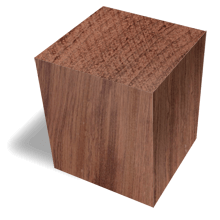
Bubinga
Bubinga, derived from the Guibourtia genus (commonly Guibourtia demeusei, G. pellegriniana, or G. tessmannii), is a tropical hardwood native to Central and West Africa, including Cameroon, Gabon, and the Congo Basin. These trees thrive in dense rainforests, often near rivers or swampy areas, growing to impressive heights of 100–150 feet with trunk diameters of 3–6 feet, and some specimens featuring heavily buttressed bases.
The heartwood of Bubinga is visually stunning, ranging from a pinkish-red to a deep reddish-brown, often with darker purple or black streaks that add depth and contrast. The sapwood is a pale straw colour, sharply distinct from the heartwood. The grain is typically straight to interlocked, sometimes wavy, with a fine to medium texture and a moderate to high natural lustre. Bubinga is renowned for its figured patterns, such as pommele, waterfall, flamed, quilted, or mottled, which make it highly sought after for decorative purposes.
Bubinga has a density of around 800–900 kg/m³, making it a hard, heavy, and durable wood with good strength and stability once seasoned. It’s moderately to very durable, with resistance to moisture, fungi, termites, and marine borers, though it’s vulnerable to the common furniture beetle. The heartwood is resistant to preservative treatments, and its high oil content can make gluing challenging—wiping with a solvent like alcohol before bonding is advised. The interlocked grain may cause tearout during planing, and its silica content can dull tools, so sharp, carbide-tipped blades are recommended. It finishes beautifully, with oil or varnish enhancing its rich colours and figuring.
When worked, Bubinga has a mild, sweet scent, though wet lumber may emit an unpleasant odour that fades once dry. It’s widely used for high-end furniture, cabinetry, veneer, musical instruments (e.g., guitar bodies, drum shells), and turned objects like knife handles or pen blanks. Its acoustic properties, offering a mellow, well-rounded tone, make it a favourite among luthiers. In the UK, it’s often marketed as “African Rosewood,” though it’s not a true rosewood, and its use in luxury applications reflects its premium status.
Bubinga is moderately expensive, with figured pieces commanding higher prices. However, its sustainability is a concern—three Guibourtia species are listed on CITES Appendix II, and G. pellegriniana and G. tessmannii are endangered, while G. demeusei is near-threatened, according to the IUCN Red List. Overharvesting, particularly for the Chinese hongmu market, has led to export restrictions, impacting availability. Responsible sourcing is critical to ensure its future.
